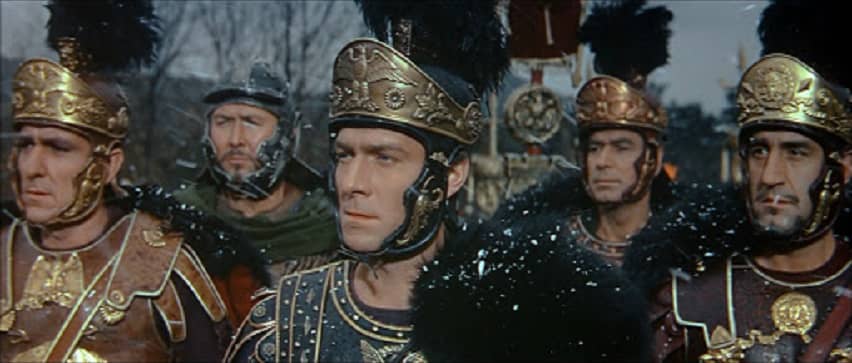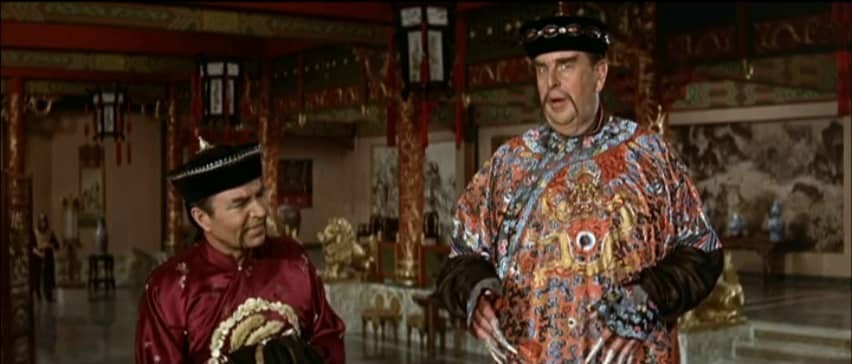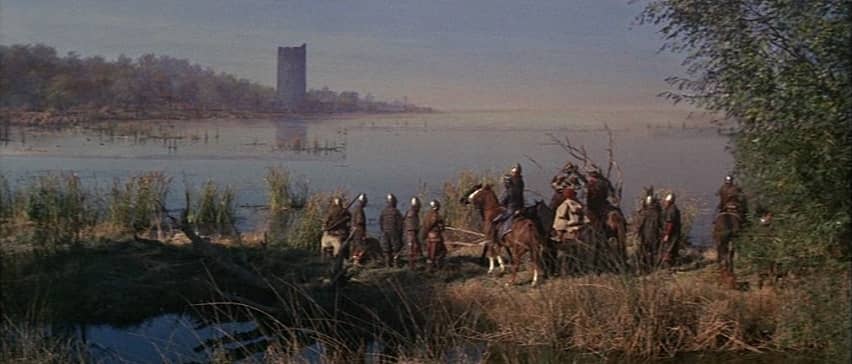Ellsworth’s Cinema of Swords: The Fall of the Hollywood Epic
The Fall of the Roman Empire (USA, 1964)
Big-studio Hollywood historical epics had a good run, arguably starting with the films of Cecil B. DeMille in the Twenties, flourishing throughout the Fifties and peaking around 1960 with grand features like Ben-Hur (1959) and Lawrence of Arabia (1962). But in the early Sixties the theater-going public seems to have lost their taste for big epics, right about the time those same epics began letting them down, either becoming unbearably ridiculous in their depictions of other cultures or bogged down in turgid self-importance. Actors like Charlton Heston, who’d made a career out of swaggering through ancient and medieval studio sets with a sword on his hip, gave historical epics one last go and then shrugged and reinvented themselves as Seventies action stars.
The Fall of the Roman Empire
Rating: **
Origin: USA, 1964
Director: Anthony Mann
Source: Genius Products DVD
A grand historical epic, from the producer and director who’d made El Cid (1961), starring Sophia Loren, Christopher Plummer, Alec Guinness, and James Mason, with cinematography by the great Robert Krasker and action scenes directed by Yakima Canutt, in the same late Roman setting as Ridley Scott’s Gladiator (2000). What could go wrong?
The Fall of the Roman Empire is an object lesson in how little the above matters when your movie has a crap story. The script here is dead in the water, with characters continually talking past each other, declaiming in tone-deaf speech after speech, but all those grandiose speeches still aren’t enough exposition to put the story across, so they’re backed up by ill-placed internal monologues that drag it down further. The dialogue is pompous, self-important, and oh-so-significant, and the visual storytelling is little better.
Oh, it’s pretty enough, especially the first hour, set in the snowy forests of central Europe, with magnificent sets and fabulous costumes, but the costumes are worn by passionless mannequins sleepwalking through their parts. And the worst of these is Stephen Boyd as the nominal lead, General Gaius Livius: Boyd is a handsome nullity, an empty suit of Roman armor, and if he doesn’t strike a single spark with Sophia Loren as his supposed great love Lucilla, it’s no surprise.
Loren is wasted here, and so is James Mason as the saintly philosopher Timonides: saintly just isn’t a good look for Mason. On the plus side, Alec Guinness does his best as the dying Caesar Marcus Aurelius, but he’d have done a lot better if his dialogue didn’t sound like it came out of a textbook. In truth, only Christopher Plummer manages to find any juice in his role, but then he gets to be the odious villain, the increasingly mad Emperor Commodus. Plummer is the only one who’s really jumped aboard this train wreck, and he gleefully seizes engineer’s levers and drives the train right off the bridge. When Plummer is on screen this movie is worth watching, but otherwise the three-plus hours of speeches and Roman processions — so many processions! — are barely tolerable.
True, occasionally there’s some action between the speeches and processions. There are two fairly decent battles directed by Canutt, the best being a skirmish between the legionaries and the Germanic barbarians in the wintry forest. There’s a ridiculous fight between two chariot drivers as their rigs careen down narrow mountain roads, jumping downed trees and teetering on precipices — come on, guys, just stop those things, step down and fight it out on terra firma. There are also a couple of unconvincing clashes with short swords, but it’s all made up for by the climactic two-man javelin duel in a square walled in by Roman soldiers with interlocking shields. It’s spectacular, and worth putting up with an hour of speeches and processions — but probably not two hours, and certainly not three. This overwrought turkey tanked at the box office, and the verdict of the viewing public was spot on.
Genghis Khan
Rating: ***
Origin: UK/West Germany/Yugoslavia/USA, 1965
Director: Henry Levin
Source: Columbia Blu-ray
Mongols-à-go-go! The tribe of Temujin (Omar Sharif) is slaughtered and he’s enslaved by Jamuga (Stephen Boyd) of the Merkits. While toiling with a yoke around his neck, Temujin falls for Jamuga’s intended, Bortai (Françoise Dorleac). Then, with the help of wise advisor Geen (Michael Hordern) and mute warrior Sengal (Woody Strode), he escapes and, aided by the wily Shan (Telly Savalas) collects a tribe of raiders, the nucleus of the Mongol hordes to come.
Notice any Asians in the cast named above? Why, no. The white karst mountains of Yugoslavia stand in for the peaks of central Asia here in the same way that white Europeans and Americans (with the exceptions of Sharif and Strode) stand in for Mongols. It gets worse when Temujin and his barbaric buddies get to China, where James Mason appears as diplomat Kam Ling while the Emperor of All China is played by Robert Morley, no less. Now, Morley is a great comic actor who is never less than entertaining, but he’s English all the way to the points of his absurdly long fingernails, and casting him as the Emperor of China is just insulting. And James Mason, to his eternal shame, is even more embarrassing, squinting with an overbite and playing Kam Ling as a cartoon Chinee out of Terry and the Pirates. Ugh.
Okay, enough about the whitewashing: how is this film as a spectacle of sword-waving horsemen sweeping across the endless plains? Mostly pretty good. It was shot by the great Geoffrey Unsworth, so it’s plenty scenic, and director Henry Levin had a long history of helming B-pictures which gives him a good feel for the action scenes; the two big cavalry battles here are surprisingly tight and punchy, and Temujin’s raid on a camp of slavers is tense and suspenseful. Levin is less impressive with the character scenes, which are sexist even for 1965, and the movie slows sadly down when it gets stuck in China for most of its second hour. Eventually Temujin, now dubbed Genghis Khan, shows the Chinese what gunpowder is really for and busts out of Peking, taking all his now-well-armed troops with him. A narrator and some burning lines on a map then describe his series of mighty conquests, all leading up to his final confrontation with Jamuga.
There isn’t much real history to this noisy melodrama, though it’s better in that regard than John Wayne’s The Conqueror. But does that matter when you’ve got Eli Wallach in a sparkly silver fez weaseling away as the Shah of Khwarezm? Shrug and roll with it.
The War Lord
Rating: ****
Origin: USA, 1965
Director: Franklin Schaffner
Source: Eureka Blu-ray
This largely overlooked film may be the best depiction of medieval warfare of the Sixties. It stars Charlton Heston, who was instrumental in getting it made, and is based on a play by Leslie Stevens, so it has a script that’s far more literate than you get in the usual knights-vs.-Vikings movie. It has an excellent score by Jerome Moross (The Big Country), plus the action sequences were arranged by Yakima Canutt’s son Joe, and they’re tremendously good.
It’s the 11th century: war-weary Norman knight Chrysagon de la Crux (Heston) is sent by his lord, the Duke of Ghent, to take command of a remote coastal domain protected by a single round three-story tower. As he and his company of veteran warriors arrive in Chrysagon’s marshy new holding, they pass stone menhirs and holy trees that clearly show that the locals, though nominally Christian, still hold with pagan religious customs. Suddenly a wounded peasant staggers out in front of the mounted knight and gasps that the village is being raided by Frisians (Lowland Vikings), and the Normans must ride instantly into battle. After a short, sharp skirmish the Frisians are driven off, but the son of their chieftain is taken captive by Chrysagon’s dwarf falconer Volc (Sammy Ross, excellent) and forced to become his page and servant.
Next comes the love story: the actors give it their all, but despite that, it still isn’t entirely convincing. Chrysagon falls for dewy young peasant woman Bronwyn (model Rosemary Forsyth), but she’s betrothed to hot-headed Marc (James Farentino), the son of the local headman. Though he wants her for himself, Chrysagon, in his capacity as new local lord, gives Bronwyn and Marc permission to marry, and is ready to suck it up as just one more disappointment in a life full of them, until his trouble-making brother Draco (Guy Stockwell) points out that by local custom, the lord has the right to bed a new bride on the night of her marriage. (Yep, here it is, the droit de seigneur, which no matter how often it’s debunked keeps rearing its head in historical fiction as an attractive male sex fantasy.) Chrysagon claims his right of a single night with Bronwyn, but when dawn comes, he — and she! — refuse to part, despite the disapproval of the knight’s loyal bodyguard Bors (second-billed Richard Boone) who glowers and grunts like a surly bear. Meanwhile the outraged groom, Marc, runs off to inform the Frisian Chieftain that his son is held in the tower, the Vikings return in force, and the real trouble begins.
The second half of the film is mainly a top-notch small-scale siege action, as the Frisians deploy various stratagems to get into the Normans’ stone tower, including a covered battering ram, flaming brush piles at the wooden door, and finally a great rolling wooden tower as tall as the fort it’s attacking. It’s all tautly and ingeniously directed by Franklin Schaffner, who though previously known for dramatic character studies turns out to have genuine feel for exciting medieval combat. This film was an attempt to get away from the Technicolor Camelot era of Hollywood films of knights in shining armor and portray the Middle Ages as they really were, and it mostly succeeds: the arms and armor on both sides are authentic to the period, and the combat is lethal and bloody. Heston wanted to shoot the film on location in the English marsh country, but Universal refused and insisted it be filmed in their expansive backlot, and though matte paintings and mist are used to give the impression the action is taking place in medieval Europe rather than southern California, the results are pretty convincing. We won’t tip the ending here, but it’s just as grim and earthy as the story that precedes it. Look for Cecil B. DeMille’s old leading man Henry Wilcoxon shaking his axe as the Frisian Chieftain. Director Schaffner and star Heston would team up again two years later to make a film that has overshadowed this one, good as it is: Planet of the Apes.
Where can I watch these movies? I’m glad you asked! Many movies and TV shows are available on disk in DVD or Blu-ray formats, but nowadays we live in a new world of streaming services, more every month it seems. However, it can be hard to find what content will stream in your location, since the market is evolving and global services are a patchwork quilt of rights and availability. I recommend JustWatch.com, a search engine that scans streaming services to find the title of your choice. Give it a try. And if you have a better alternative, let us know.
The previous installments in the Cinema of Swords include:
The 7th Voyage and Its Children
The Good, the Bad, and Mifune
The First British Invasion
Wholesome Buccaneers (Pt. 1)
The Tale of Zatoichi
The Sign of the Z!
Gallic Gallantry
Classic, Mythic and Epic
The Exuberant Excess of Sixties Vikings
Tyrone’s Typecast Troubles
Not-So-Wholesome Buccaneers
Daimajin Strikes Again!
Three Counts of Monte Cristo
Mongols, Cossacks, And Tartars
I Heard You Like Swords
Bard’s Tales
Hu’s on First
Flynn’s Last Flourishes
Mighty Colossi And Hydrae
Rejecting Bushido (Part One)
Pirates — Italian Style
The Year of Camelot and Scarecrows
Rejecting Bushido (Part Two)
LAWRENCE ELLSWORTH is deep in his current mega-project, editing and translating new, contemporary English editions of all the works in Alexandre Dumas’s Musketeers Cycle, with the fifth volume, Between Two Kings, coming in July from Pegasus Books in the US and UK. His website is Swashbucklingadventure.net.
Ellsworth’s secret identity is game designer LAWRENCE SCHICK, who’s been designing role-playing games since the 1970s. He now lives in Dublin, Ireland, where he’s writing Dungeons & Dragons scenarios for Larian Studios’ Baldur’s Gate 3.



That third one looks interesting – Ireland is dotted with Norman keeps and there’s a couple near me, one right on the edge of the local lake. It actually looks just like your photo (although the keeps are all oblong rather than round).
The movie was remarkably historically accurate in terms of costume but the Round stone tower was out of place for the time and the region.
Sad that you didn’t like TFoTRE, but I have been a sucker for Stephen Boyd ever since Ben-Hur. And glad you like The Warlord, one of my all time favourite films…but then I have been a sucker for Charlton Heston ever since Ben-Hur.
I am a sucker for Sophia Loren – those cheekbones are classic…among other things
Don’t forget that “Fall of the Roman Empire” is also obviously the source material (Far more than actual history is) for Ridley Scott’s “Gladiator”, which is a better film, but I can’t really love because of its shameless use of other people’s work without so much as a nod: the script of “Fall”, Zimmer’s blatant use of Holst and Wagner in writing the score, etc.
Now, The Warlord is one of the best and most overlooked medieval films, period. From the Frisian helmets and long hauberks (granted, not of real mail), to it’s 11th c keep, this is just a fantastic looking film, with a lot of heart and a poignant ending. I love it to death!
I first saw THE WAR LORD on tv sometime in the late 1960s and it remains one of my favorite historical movies, ever. Time to see it again.
The last time I caught TFotRE was the early 90s, and I have to say that I loved that chariot chase scene down the mountain. Loved. It.
I caught The Warlord in the mid-80s and really didn’t like it, but I was like 13 at the time, so perhaps a re-watch is in order.
Another Ellsworth’s Cinema of Swords? Oh, thank Jupiter!
I never managed to finish watching Genghis Khan, and TFotRE is just one big snooze except for the battles and that duel, but I own a copy of the Warlord and have watched it a number of times. It has a great feel to it and even Richard Boone seems to fit in. A favorite of mine.
Heston is great in the War Lord, heroic but fallible. Guy Stockwell is t
Guy Stockwell is the most villainous little brother this side of Tom Hiddleston. And let’s face it, what could be cooler than having Richard Boone as your loyal henchman?
I have a long cherished copy of the Warlord on VHS but I see Amazon recently made it available on Bluray and DVD along with many other titles from that period. Definitely worth getting.
This is the first real disagreement I’ve had with these lists. Fall of the Roman Empire is a marvelously intelligent epic, far surpassing Gladiator in it’s sweep and ambition. Hell, I would even compare it to Spartacus in its overall power and majesty.
Glad you mentioned The War Lord. It is just sooooooo good, and as you noted, without it we wouldn’t have had Planet of the Apes.